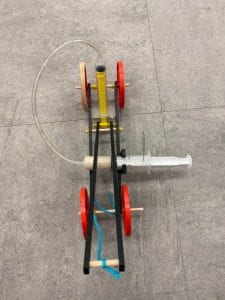
In biology, we had to make yeast mobiles, which are cars that are powered by yeast reactions. There were two syringes on the car. One had a combination of yeast, sugar and water, and the other was empty and was connected to the former by a tube. The carbon dioxide created from the yeast reaction pushed air into the empty syringe, which moved the car. In order to have our car go as far as it possibly could, my group members and I first needed to figure out what ratio of yeast:water:sugar had the quickest reaction. Then, we built a car that was designed to go a long way. We discovered that we had the best outcome when using more yeast than sugar, and warm water. If I had a chance to change our car, I’d probably put more effort into the actual shape of the car. We did not really spend that much time on it, and I feel like if we did the car might’ve traveled a longer distance.
This experiment helped me to better understand the process of fermentation since we got to see, first-hand, how much gas the reaction releases. I’m still not sure how exactly this occurs. I know it happens to turn NADH into NAD+, but that is really all I know about the whole process of fermentation.
I worked on this project with three other people. Talking to them to figure out how to build the car was really helpful. I would not have been able to figure that out myself. Also, having more than one person doing the experiments to find out which yeast/sugar/water combination had the quickest reaction. We tested a few different ratios, and having two people working on it helped to go faster. In addition, we were able to choose the shapes of our car. We used our creativity to build our unique car that we believed would be the most efficient.